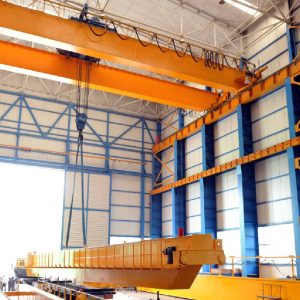
Ergonomic considerations in lifting and material handling processes play a pivotal role in reducing the high costs associated with workplace injuries. Companies that prioritize ergonomics not only protect their workforce from MSDs but also witness increased productivity. By aligning the job with the capabilities of the worker, ergonomic practices create a safer and more efficient working environment.
Read more about how ergonomic lifting equipment can benefit your workforce and how Demag KBK Crane Systems make lifting and handling more ergonomic for your workforce.
In the fast-paced world of industrial operations, the safety and efficiency of overhead lifting and material handling are paramount. Recognizing the importance of ergonomic practices, regulatory bodies such as the Occupational Safety and Health Administration (OSHA) stress the need for proper techniques, equipment design, and work practices to prevent workplace injuries, particularly those related to musculoskeletal disorders (MSDs).
Work-related musculoskeletal disorders account for a significant portion of occupational injuries and illnesses, resulting in substantial costs for companies in terms of medical expenses, lost productivity, and workers' compensation. Ergonomics, the science of fitting the job to the worker, emerges as a crucial factor in mitigating these costs and enhancing overall productivity.
Ergonomics: A Cost-Effective Solution
Ergonomic considerations in lifting and material handling processes play a pivotal role in reducing the high costs associated with workplace injuries. Companies that prioritize ergonomics not only protect their workforce from MSDs but also witness increased productivity. By aligning the job with the capabilities of the worker, ergonomic practices create a safer and more efficient working environment.
According to OSHA*, repetitive strain injuries and musculoskeletal disorders alone constitute approximately one-third of all occupational injuries. Ergonomics becomes the linchpin in addressing this occupational health challenge and minimizing its impact on both workers and the bottom line.
The Evolution of Ergonomic Lifting Equipment
Manual lifting of heavy materials stands out as a common cause of workplace injuries. To address this, ergonomics advocates for the use of mechanized equipment such as chain hoists and enclosed rail crane systems. These tools not only make material handling more efficient but also significantly reduce the risk of injuries associated with manual lifting.
Ergonomics go beyond equipment choice, focusing on optimizing workstation design to facilitate proper body mechanics and minimize unnecessary movements during material handling activities. A standout example of advanced ergonomic design is the Demag KBK Modular Crane System.
Demag KBK Modular Crane Systems: Redefining Ergonomic Performance
Designed with ergonomic use in mind, Demag KBK Modular Crane Systems offer unparalleled benefits in the realm of lifting and material handling. The steel and aluminum tracks are coated inside and out to ensure protection from corrosion, providing smooth, long-term ergonomic performance.
One of the standout features is the low rolling resistance trolleys, optimizing ergonomic performance in manual push/pull applications. The smooth travel, along with easy installation and adjustability, makes the KBK system a leader in ergonomic lifting equipment.
Articulation creates unparalleled ergonomic performance for your workforce. The key articulating components of KBK, including the track suspension hanger and crane eye, allow for 360-degree motion, enabling the crane bridge to skew. This unique feature reduces binding, making tasks such as starting, moving, and stopping loads more effortless for operators. Unlike rigid systems, Demag KBK's articulating system ensures ergonomic handling and performance throughout the entire system, especially when handling heavy loads near the ends of the bridge.
Investing in Ergonomic Training
To maximize the benefits of ergonomic equipment, proper training is paramount. Ergonomic training and education programs empower workers with the knowledge and skills needed to execute tasks safely. OSHA encourages employers to provide such training to ensure a workforce equipped for ergonomic success in material handling operations.
Creating a Safer, More Efficient Future
Creating an ergonomic working environment is not just a goal; it's a critical Key Performance Indicator (KPI). The costs associated with repetitive strain injuries and MSDs can be substantial, but a focus on ergonomics can alleviate these financial burdens while boosting overall productivity.
When evaluating lifting and material handling processes, companies should look for purpose-built equipment designed to enhance ergonomics. Demag KBK Crane Systems stand as a testament to the advancements in ergonomic technology, offering unparalleled performance and safety. Invest in ergonomics, invest in the future of your workforce.
Watch our video to learn more about how articulation can improve ergonomics for your workforce. Contact us to discuss your challenges and explore how ergonomic solutions can transform your operations. For more information on Demag KBK Crane Systems, visit our website.
*Source: OSHA Ergonomic Overview Handout -Link: https://www.osha.gov/sites/default/files/2018-12/fy14_sh-26336-sh4_Ergonomic-Overview-Handout.pdf






